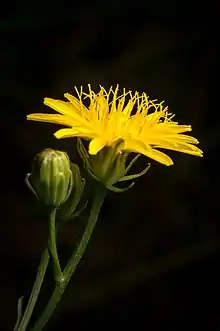| Crepis vesicaria subsp. taraxacifolia | |
|---|---|
 | |
| Scientific classification | |
| Kingdom: | Plantae |
| Clade: | Tracheophytes |
| Clade: | Angiosperms |
| Clade: | Eudicots |
| Clade: | Asterids |
| Order: | Asterales |
| Family: | Asteraceae |
| Genus: | Crepis |
| Species: | |
| Subspecies: | C. v. subsp. taraxacifolia |
| Trinomial name | |
| Crepis vesicaria subsp. taraxacifolia (Thuill.) Thell. | |
Crepis vesicaria subsp. taraxacifolia, the beaked hawksbeard, is a subspecies of flowering plant in the family Asteraceae. It is native to Europe and northwest Africa.[1] It has become naturalized in scattered locations in the United Kingdom, North America, and Oceania.[1][2][3]
Description
Crepis vesicaria subsp. taraxacifolia reaches 4 ft (120 cm) in height, with each of many branches producing yellow, dandelion-like flower heads at the tips.[2]
At the base of the plant are long leaves 4 to 14 in (10 to 36 cm). Smaller leaves connect directly to the stem. Leaves are irregularly and deeply lobed. [2]
The underside of each flower head has two layers of leaf-like phyllaries. The inner phyllaries are longer and pointed, and often curl back away from the flower head. The outer layer of phyllaries is substantially shorter.[2]
References
- 1 2 "Crepis vesicaria subsp. taraxacifolia". Plants of the World Online. Royal Botanical Gardens Kew. Retrieved 24 May 2019.
- 1 2 3 4 Bogler, David (2012). "Crepis vesicaria subsp. taraxacifolia". Jepson Flora Project (eds.) Jepson eFlora.
- ↑ "Crepis vesicaria subsp. taraxacifolia". New Zealand Plant Conservation Network. Retrieved 23 May 2019.